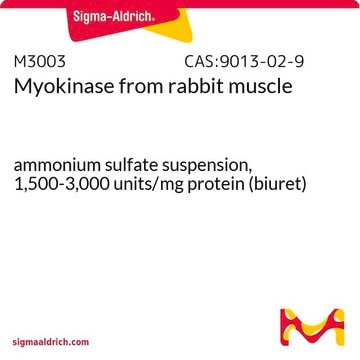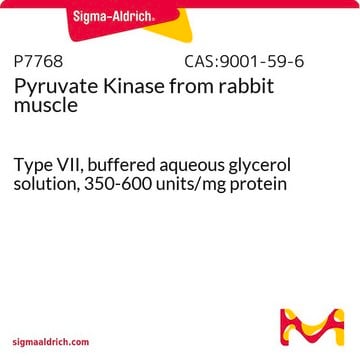P4390
Polynucleotide Kinase from T4-infected Escherichia coli
10 units/μL, buffered aqueous glycerol solution
Sign Into View Organizational & Contract Pricing
All Photos(1)
About This Item
CAS Number:
MDL number:
UNSPSC Code:
12352204
NACRES:
NA.53
Recommended Products
grade
for molecular biology
form
buffered aqueous glycerol solution
mol wt
33 kDa
concentration
10 units/μL
foreign activity
Endonuclease and exonuclease, none detected
shipped in
wet ice
storage temp.
−20°C
Looking for similar products? Visit Product Comparison Guide
Application
Suitable for:
- Sequencing or nucleic acid tagging (DNA and RNA) by 5′-end labeling
- 5′ phosphorylation of oligonucleotides
- Removal of 3′-phosphate groups from phosphorylpolynucleotides
Components
T4 Polynucleotide Kinase is supplied in a solution of 50% glycerol (v/v), 20 mM Tris-HCl (pH 7.5), 25 mM KCl, 2mM DTT, 0.1 mM EDTA, and 0.1 μM ATP.
Principle
Polynucleotide kinase catalyses a "forward reaction" transfer of the γ-phosphate of ATP to the 5′ hydroxyl terminus of single- and double-stranded nucleic acids (DNA and RNA) and 3′-nucleoside monophosphates. In exchange reactions containing ADP, the enzyme will catalyze the exchange of 5′-terminal phosphate groups and ATP. The 3′-phosphatase activity enables the enzyme to remove 3′-phosphoryl groups from phosphorylpolynucleotides.
1. Forward reaction: Transfer of the labeled γ-phosphate from [γ-32P]-ATP to the free 5′-hydroxyl group of the substrate.
5′-HO-DNA + [γ-32P]-ATP → 5′-32PO-DNA + ADP.
Substrates that do not have a free 5′-hydroxyl require prior dephosphorylation by alkaline phosphatase.
2. Exchange reaction: First, the terminal 5′-phosphate is transferred from the substrate to ADP present in the reaction mixture. Then, the labeled γ-phosphate from [γ-32P]-ATP is transferred to the free hydroxyl group of the substrate.
5′-PO-DNA + ADP → 5′-HO-DNA + ATP
5′-HO-DNA + [γ-32P]-ATP → 5′-32PO-DNA + ADP
1. Forward reaction: Transfer of the labeled γ-phosphate from [γ-32P]-ATP to the free 5′-hydroxyl group of the substrate.
5′-HO-DNA + [γ-32P]-ATP → 5′-32PO-DNA + ADP.
Substrates that do not have a free 5′-hydroxyl require prior dephosphorylation by alkaline phosphatase.
2. Exchange reaction: First, the terminal 5′-phosphate is transferred from the substrate to ADP present in the reaction mixture. Then, the labeled γ-phosphate from [γ-32P]-ATP is transferred to the free hydroxyl group of the substrate.
5′-PO-DNA + ADP → 5′-HO-DNA + ATP
5′-HO-DNA + [γ-32P]-ATP → 5′-32PO-DNA + ADP
Unit Definition
One unit catalyzes the transfer of one nanomole of 32P to the 5′-end of micrococcal nuclease-treated DNA in 30 min. at 37 °C. Transfer is detected as incorporation into acid-insoluble material.
Analysis Note
Activity is determined in a reaction mixture containing 40 mM Tris-HCl (pH 7.5), with 10 mM MgCl2, 5 mM dithiothreitol, 0.5 mM 5′-OH polynucleotide ends, and mM [γ-32P]-ATP.
related product
Product No.
Description
Pricing
Glutathione S-Transferase from E. coli, recombinant, expressed in E. coli, buffered aqueous solution
Ribonuclease A from bovine pancreas, for molecular biology, ≥70 Kunitz units/mg protein, lyophilized
Signal Word
Danger
Hazard Statements
Precautionary Statements
Hazard Classifications
Resp. Sens. 1
Storage Class Code
10 - Combustible liquids
WGK
WGK 3
Flash Point(F)
Not applicable
Flash Point(C)
Not applicable
Personal Protective Equipment
dust mask type N95 (US), Eyeshields, Gloves
Certificates of Analysis (COA)
Search for Certificates of Analysis (COA) by entering the products Lot/Batch Number. Lot and Batch Numbers can be found on a product’s label following the words ‘Lot’ or ‘Batch’.
Already Own This Product?
Find documentation for the products that you have recently purchased in the Document Library.
Sandeep K Sharma et al.
Nature chemical biology, 6(12), 914-920 (2010-10-19)
Hsp70-Hsp40-NEF and possibly Hsp100 are the only known molecular chaperones that can use the energy of ATP to convert stably pre-aggregated polypeptides into natively refolded proteins. However, the kinetic parameters and ATP costs have remained elusive because refolding reactions have
Polynucleotide kinase exchange reaction: quantitave assay for restriction endonuclease-generated 5'-phosphoroyl termini in DNA.
K L Berkner et al.
The Journal of biological chemistry, 252(10), 3176-3184 (1977-05-25)
Lei Lin et al.
Analytical chemistry, 83(22), 8396-8402 (2011-10-27)
Phosphorylation of DNA with 5'-hydroxyl termini plays a critical role in a majority of normal cellular events, including DNA recombination, DNA replication, and repair of DNA during strand interruption. Determination of nucleotide kinase activity and inhibition is under intense development
Ga Tremblay et al.
Bioanalysis, 3(5), 499-508 (2011-03-11)
Oligonucleotide-based therapeutics are quantified with hybridization assays in biological matrices such as plasma and tissues. Current hybridization methods do not entirely discriminate the parent compound from 5´- or 3´-N-X truncated metabolites. A dual ligation-based hybridization assay was developed to circumvent
A role in true-late gene expression for the T4 bacteriophage 5' polynucleotide kinase 3' phosphatase.
K Sirotkin et al.
Journal of molecular biology, 123(2), 221-233 (1978-08-05)
Our team of scientists has experience in all areas of research including Life Science, Material Science, Chemical Synthesis, Chromatography, Analytical and many others.
Contact Technical Service







